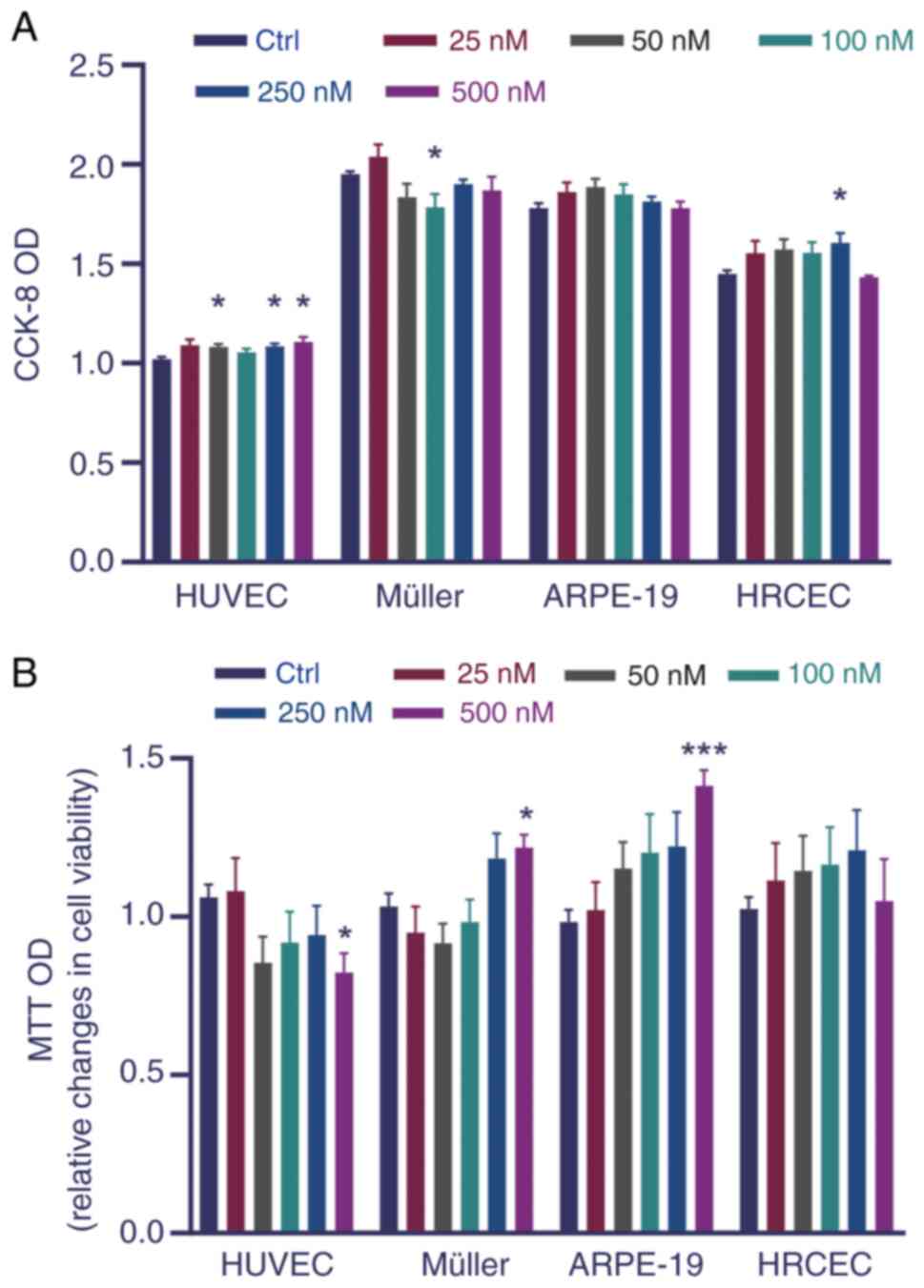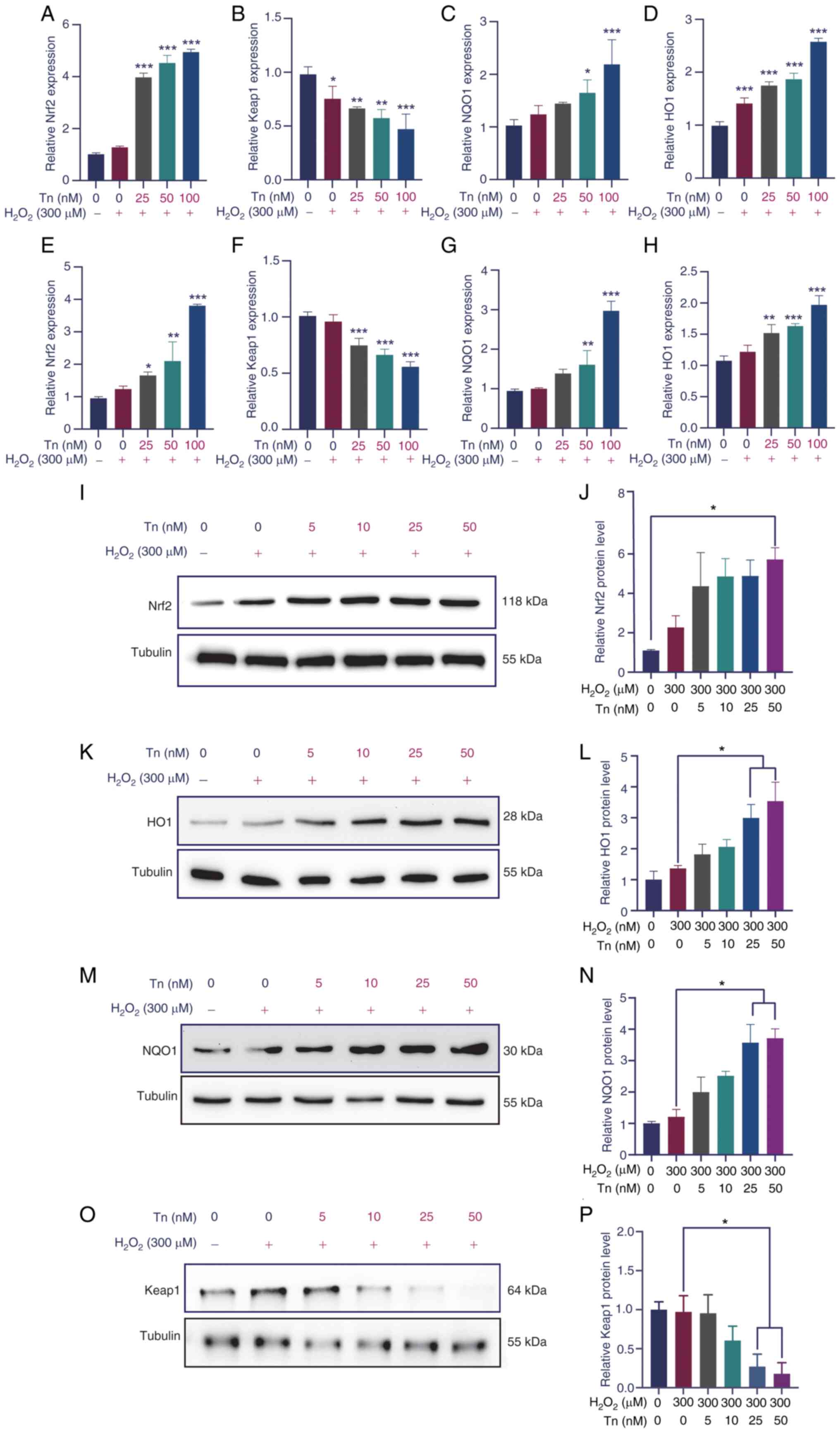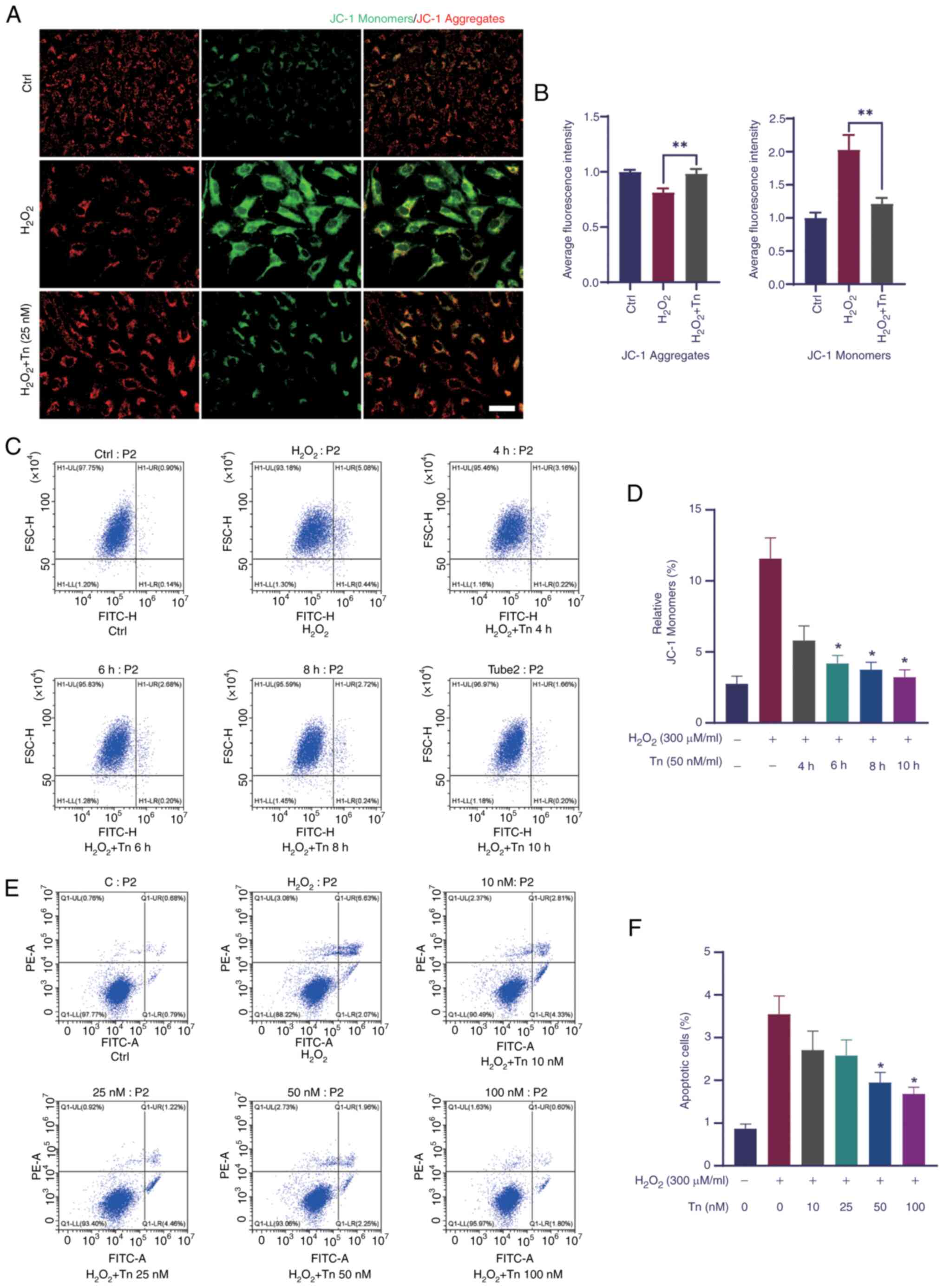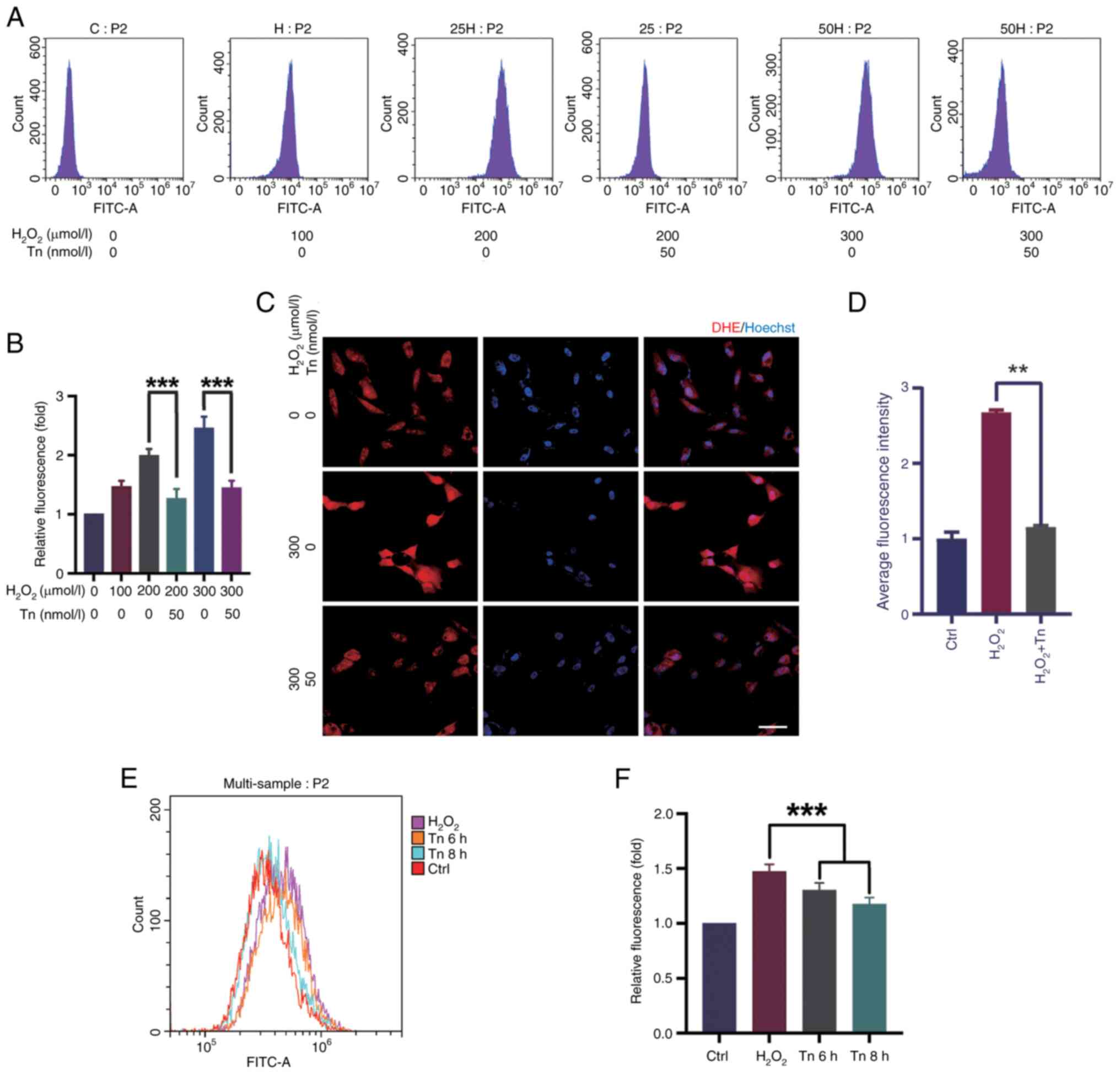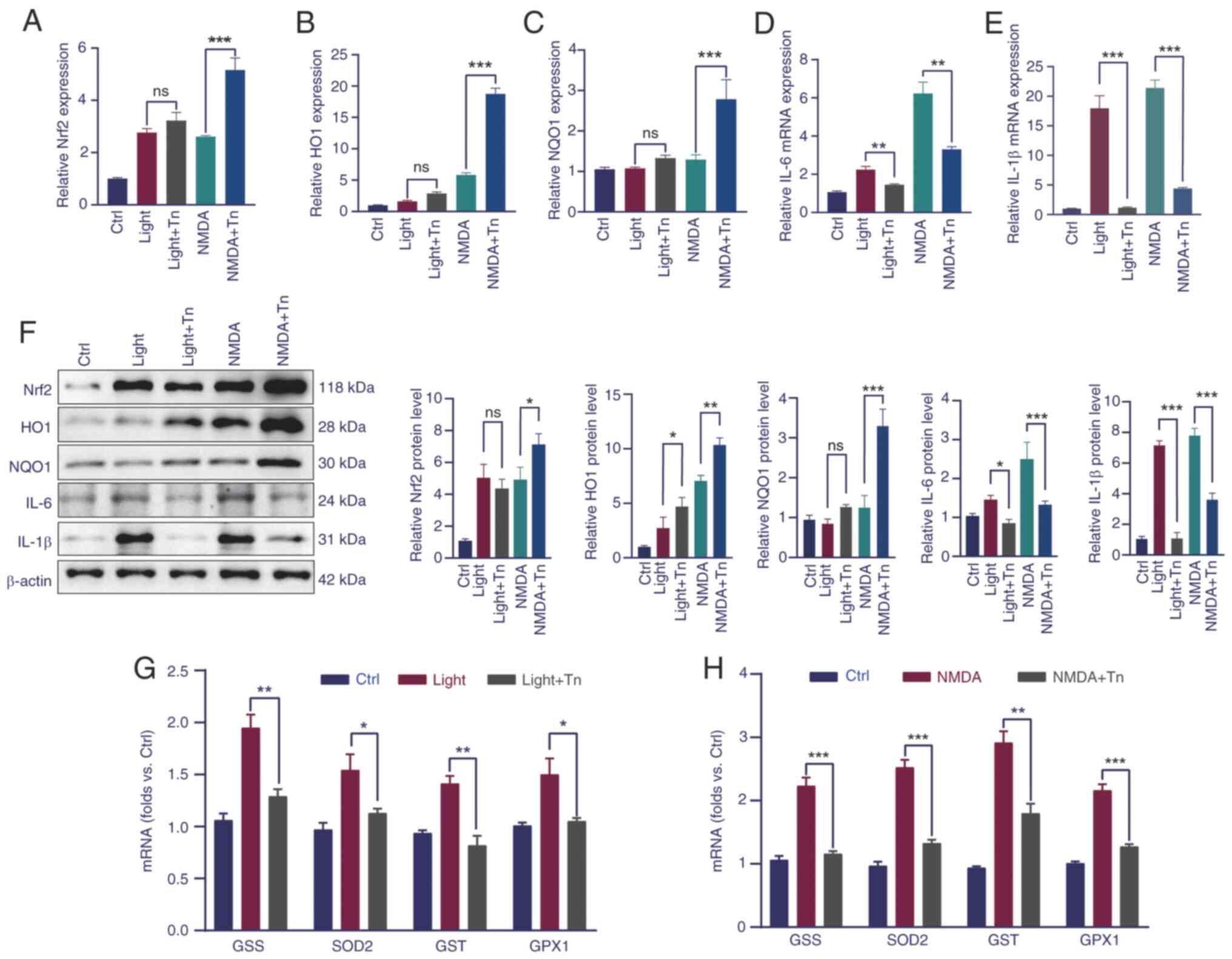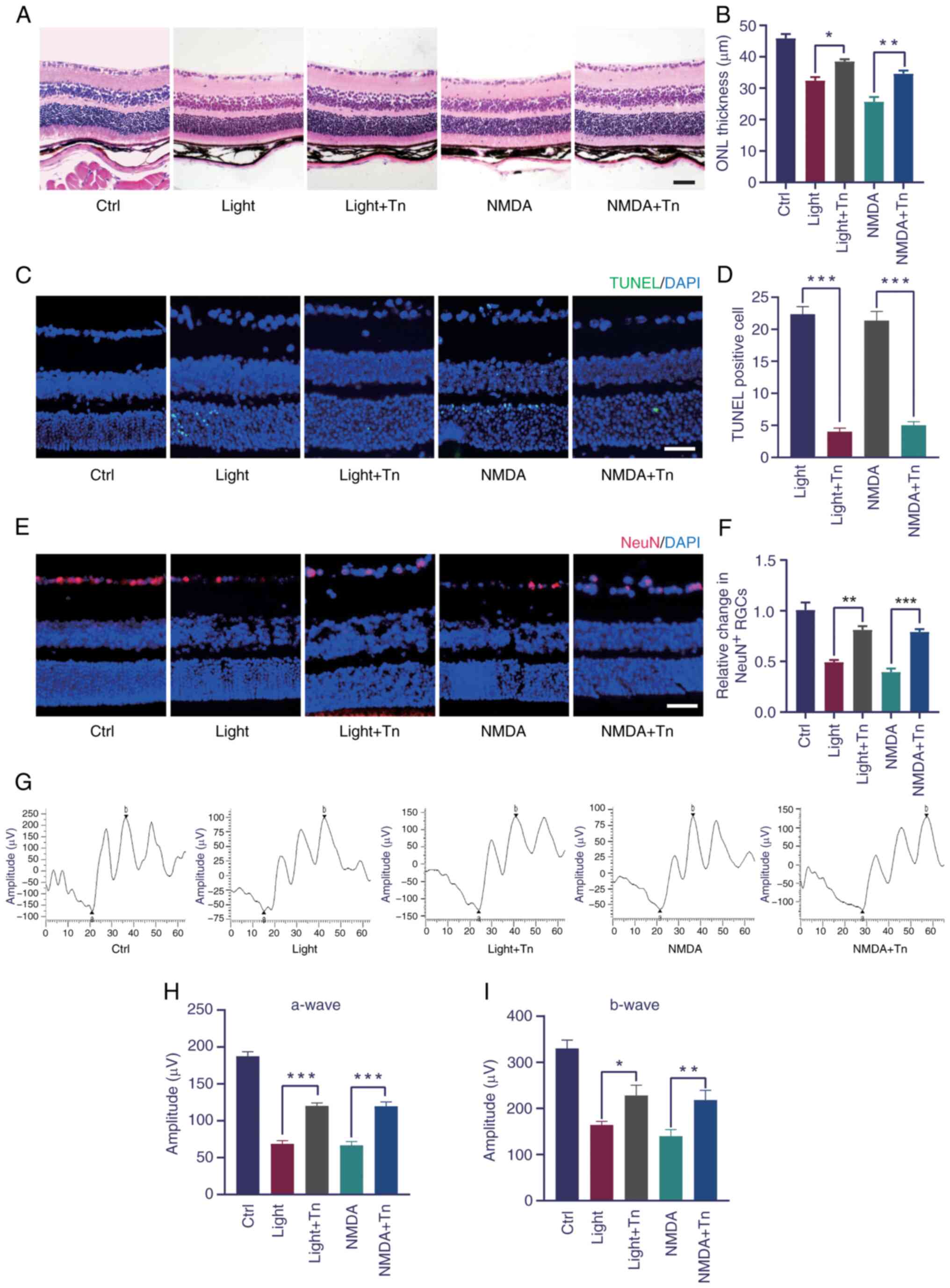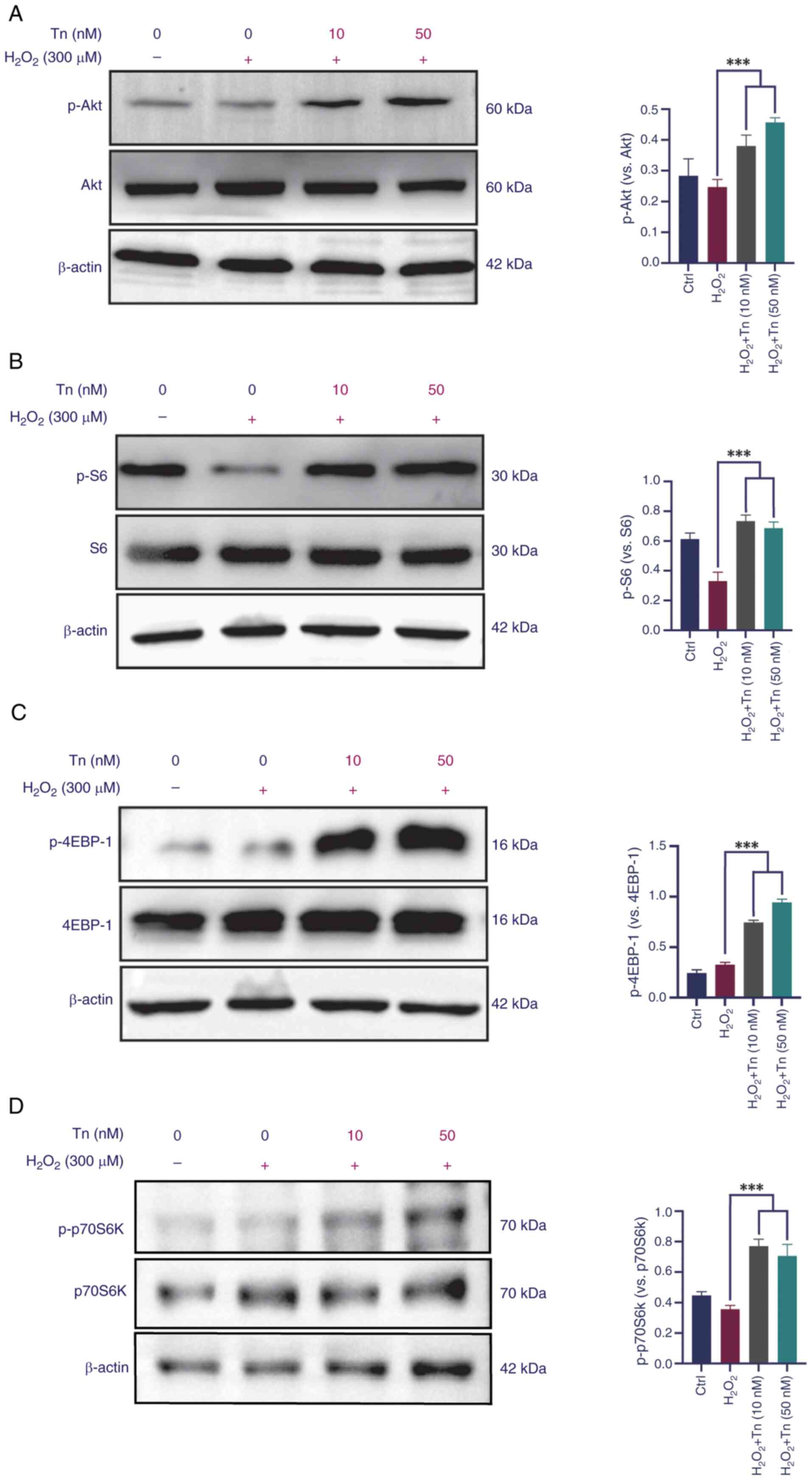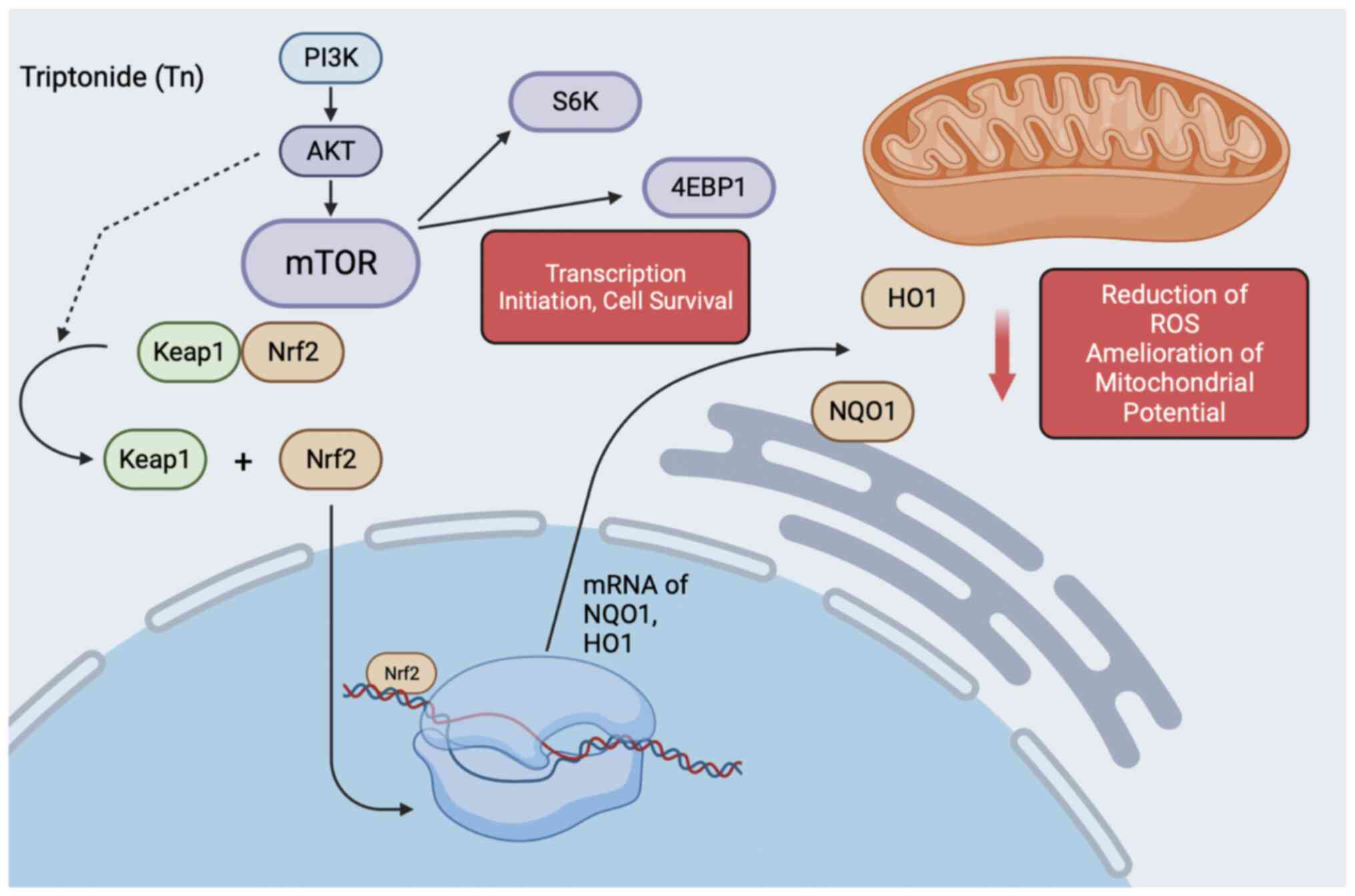|
1
|
Thomas CJ, Mirza RG and Gill MK:
Age-related macular degeneration. Med Clin North Am. 105:473–491.
2021. View Article : Google Scholar : PubMed/NCBI
|
|
2
|
Hanus J, Anderson C and Wang S: RPE
necroptosis in response to oxidative stress and in AMD. Ageing Res
Rev. 24:286–298. 2015. View Article : Google Scholar : PubMed/NCBI
|
|
3
|
Liang FQ and Godley BF: Oxidative
stress-induced mitochondrial DNA damage in human retinal pigment
epithelial cells: A possible mechanism for RPE aging and
age-related macular degeneration. Exp Eye Res. 76:397–403. 2003.
View Article : Google Scholar : PubMed/NCBI
|
|
4
|
Tu W, Wang H, Li S, Liu Q and Sha H: The
anti-inflammatory and anti-oxidant mechanisms of the keap1/Nrf2/ARE
signaling pathway in chronic diseases. Aging Dis. 10:637–651. 2019.
View Article : Google Scholar : PubMed/NCBI
|
|
5
|
Ulyanova T, Szél A, Kutty RK, Wiggert B,
Caffé AR, Chader GJ and van Veen T: Oxidative stress induces heme
oxygenase-1 immunoreactivity in Müller cells of mouse retina in
organ culture. Invest Ophthalmol Vis Sci. 42:1370–1374.
2001.PubMed/NCBI
|
|
6
|
Flores R, Carneiro Â, Vieira M, Tenreiro S
and Seabra MC: Age-related macular degeneration: Pathophysiology,
management, and future perspectives. Ophthalmologica. 244:495–511.
2021. View Article : Google Scholar : PubMed/NCBI
|
|
7
|
Zhang X and Sivaprasad S: Drusen and
pachydrusen: The definition, pathogenesis, and clinical
significance. Eye (Lond). 35:121–133. 2021. View Article : Google Scholar
|
|
8
|
Hernández-Zimbrón LF, Zamora-Alvarado R,
Ochoa-De la Paz L, Velez-Montoya R, Zenteno E, Gulias-Cañizo R,
Quiroz-Mercado H and Gonzalez-Salinas R: Age-related macular
degeneration: New paradigms for treatment and management of AMD.
Oxid Med Cell Longev. 2018:83746472018. View Article : Google Scholar : PubMed/NCBI
|
|
9
|
García-Layana A, Cabrera-López F,
García-Arumí J, Arias-Barquet L and Ruiz-Moreno JM: Early and
intermediate age-related macular degeneration: Update and clinical
review. Clin Interv Aging. 12:1579–1587. 2017. View Article : Google Scholar : PubMed/NCBI
|
|
10
|
Cabral de Guimaraes TA, Daich Varela M,
Georgiou M and Michaelides M: Treatments for dry age-related
macular degeneration: Therapeutic avenues, clinical trials and
future directions. Br J Ophthalmol. 106:297–304. 2022. View Article : Google Scholar
|
|
11
|
Damico FM, Gasparin F, Scolari MR, Pedral
LS and Takahashi BS: New approaches and potential treatments for
dry age-related macular degeneration. Arq Bras Oftalmol. 75:71–76.
2012. View Article : Google Scholar : PubMed/NCBI
|
|
12
|
Li KR, Yang SQ, Gong YQ, Yang H, Li XM,
Zhao YX, Yao J, Jiang Q and Cao C: 3H-1,2-dithiole-3-thione
protects retinal pigment epithelium cells against Ultra-violet
radiation via activation of Akt-mTORC1-dependent Nrf2-HO-1
signaling. Sci Rep. 6:255252016. View Article : Google Scholar : PubMed/NCBI
|
|
13
|
Li KR, Zhang ZQ, Yao J, Zhao YX, Duan J,
Cao C and Jiang Q: Ginsenoside Rg-1 protects retinal pigment
epithelium (RPE) cells from cobalt chloride (CoCl2) and hypoxia
assaults. PLoS One. 8:e841712013. View Article : Google Scholar
|
|
14
|
Ong FS, Kuo JZ, Wu WC, Cheng CY, Blackwell
WLB, Taylor BL, Grody WW, Rotter JI, Lai CC and Wong TY:
Personalized medicine in ophthalmology: From pharmacogenetic
biomarkers to therapeutic and dosage optimization. J Pers Med.
3:40–69. 2013. View Article : Google Scholar : PubMed/NCBI
|
|
15
|
Liu R, Li X, Huang N, Fan M and Sun R:
Toxicity of traditional Chinese medicine herbal and mineral
products. Adv Pharmacol. 87:301–346. 2020. View Article : Google Scholar : PubMed/NCBI
|
|
16
|
Tang B, Zhu J, Zhang B, Wu F, Wang Y, Weng
Q, Fang S, Zheng L, Yang Y, Qiu R, et al: Therapeutic potential of
triptolide as an anti-inflammatory agent in dextran sulfate
sodium-induced murine experimental colitis. Front Immunol.
11:5920842020. View Article : Google Scholar : PubMed/NCBI
|
|
17
|
Liu Q: Triptolide and its expanding
multiple pharmacological functions. Int Immunopharmacol.
11:377–383. 2011. View Article : Google Scholar : PubMed/NCBI
|
|
18
|
Zheng YL, Lin JF, Lin CC and Xu Y:
Anti-inflammatory effect of triptolide. Zhongguo Yao Li Xue Bao.
15:540–543. 1994.In Chinese. PubMed/NCBI
|
|
19
|
Buendia I, Michalska P, Navarro E, Gameiro
I, Egea J and León R: Nrf2-ARE pathway: An emerging target against
oxidative stress and neuroinflammation in neurodegenerative
diseases. Pharmacol Ther. 157:84–104. 2016. View Article : Google Scholar
|
|
20
|
Baird L and Yamamoto M: The molecular
mechanisms regulating the KEAP1-NRF2 pathway. Mol Cell Biol.
40:e00099–20. 2020. View Article : Google Scholar : PubMed/NCBI
|
|
21
|
Hui Q, Karlstetter M, Xu Z, Yang J, Zhou
L, Eilken HM, Terjung C, Cho H, Gong J, Lai MJ, et al: Inhibition
of the Keap1-Nrf2 protein-protein interaction protects retinal
cells and ameliorates retinal ischemia-reperfusion injury. Free
Radic Biol Med. 146:181–188. 2020. View Article : Google Scholar :
|
|
22
|
Han S, Chen J, Hua J, Hu X, Jian S, Zheng
G, Wang J, Li H, Yang J, Hejtmancik JF, et al: MITF protects
against oxidative damage-induced retinal degeneration by regulating
the NRF2 pathway in the retinal pigment epithelium. Redox Biol.
34:1015372020. View Article : Google Scholar : PubMed/NCBI
|
|
23
|
Dai S, Wang C, Feng L, Zhang C, Zhang W,
He Y, Zhou X, Xia X, Chen B and Song W: Protective activity of
tert-butylhydroquinone against oxidative stress and apoptosis
induced by glutamate agonizts in R28 cells and mice retina. Biomed
Pharmacother. 152:1131172022. View Article : Google Scholar : PubMed/NCBI
|
|
24
|
Ozawa Y: Oxidative stress in the
light-exposed retina and its implication in age-related macular
degeneration. Redox Biol. 37:1017792020. View Article : Google Scholar : PubMed/NCBI
|
|
25
|
Wu T, Handa JT and Gottsch JD:
Light-induced oxidative stress in choroidal endothelial cells in
mice. Invest Ophthalmol Vis Sci. 46:1117–1123. 2005. View Article : Google Scholar : PubMed/NCBI
|
|
26
|
Livak KJ and Schmittgen TD: Analysis of
relative gene expression data using real-time quantitative PCR and
the 2(-Delta Delta C(T)) method. Methods. 25:402–408. 2001.
View Article : Google Scholar
|
|
27
|
Lambert V, Lecomte J, Hansen S, Blacher S,
Gonzalez ML, Struman I, Sounni NE, Rozet E, de Tullio P, Foidart
JM, et al: Laser-induced choroidal neovascularization model to
study age-related macular degeneration in mice. Nat Protoc.
8:2197–2211. 2013. View Article : Google Scholar : PubMed/NCBI
|
|
28
|
Beatty S, Koh H, Phil M, Henson D and
Boulton M: The role of oxidative stress in the pathogenesis of
age-related macular degeneration. Surv Ophthalmol. 45:115–134.
2000. View Article : Google Scholar : PubMed/NCBI
|
|
29
|
Perelman A, Wachtel C, Cohen M, Haupt S,
Shapiro H and Tzur A: JC-1: Alternative excitation wavelengths
facilitate mitochondrial membrane potential cytometry. Cell Death
Dis. 3:e4302012. View Article : Google Scholar : PubMed/NCBI
|
|
30
|
Yang F, Wu L, Guo X, Wang D and Li Y:
Improved retinal ganglion cell survival through retinal microglia
suppression by a chinese herb extract, triptolide, in the DBA/2J
mouse model of glaucoma. Ocul Immunol Inflamm. 21:378–389. 2013.
View Article : Google Scholar : PubMed/NCBI
|
|
31
|
Sakamoto K, Suzuki T, Takahashi K, Koguchi
T, Hirayama T, Mori A, Nakahara T, Nagasawa H and Ishii K:
Iron-chelating agents attenuate NMDA-Induced neuronal injury via
reduction of oxidative stress in the rat retina. Exp Eye Res.
171:30–36. 2018.PubMed/NCBI
|
|
32
|
Ferrara N: VEGF and intraocular
neovascularization: From discovery to therapy. Transl Vis Sci
Technol. 5:102016.PubMed/NCBI
|
|
33
|
Bruninx R, Betz P and Lepièce G:
Functionnal revalidation of patients with age-related macular
degeneration. Rev Med Liege. 75:711–716. 2020.In French. PubMed/NCBI
|
|
34
|
Mitchell P, Liew G, Gopinath B and Wong
TY: Age-related macular degeneration. Lancet. 392:1147–1159.
2018.PubMed/NCBI
|
|
35
|
Telander DG: Inflammation and age-related
macular degeneration (AMD). Semin Ophthalmol. 26:192–197.
2011.PubMed/NCBI
|
|
36
|
Jones BW, Watt CB, Frederick JM, Baehr W,
Chen CK, Levine EM, Milam AH, Lavail MM and Marc RE: Retinal
remodeling triggered by photoreceptor degenerations. J Comp Neurol.
464:1–16. 2003.PubMed/NCBI
|
|
37
|
Marc RE, Jones BW, Watt CB and Strettoi E:
Neural remodeling in retinal degeneration. Prog Retin Eye Res.
22:607–655. 2003.PubMed/NCBI
|
|
38
|
Pfeiffer RL, Marc RE, Kondo M, Terasaki H
and Jones BW: Müller cell metabolic chaos during retinal
degeneration. Exp Eye Res. 150:62–70. 2016.PubMed/NCBI
|
|
39
|
Amin RH, Frank RN, Kennedy A, Eliott D,
Puklin JE and Abrams GW: Vascular endothelial growth factor is
present in glial cells of the retina and optic nerve of human
subjects with nonproliferative diabetic retinopathy. Invest
Ophthalmol Vis Sci. 38:36–47. 1997.PubMed/NCBI
|
|
40
|
Yafai Y, Iandiev I, Lange J, Yang XM,
Wiedemann P, Bringmann A and Eichler W: Basic fibroblast growth
factor contributes to a shift in the angioregulatory activity of
retinal glial (Müller) cells. PLoS One. 8:e687732013.
|
|
41
|
Baby B, Antony P and Vijayan R:
Antioxidant and anticancer properties of berries. Crit Rev Food Sci
Nutr. 58:2491–2507. 2018.
|
|
42
|
Durazzo A, Lucarini M, Novellino E, Daliu
P and Santini A: Fruit-based juices: Focus on antioxidant
properties-Study approach and update. Phytother Res. 33:1754–1769.
2019.PubMed/NCBI
|
|
43
|
Chang Z, Qin W, Zheng H, Schegg K, Han L,
Liu X, Wang Y, Wang Z, McSwiggin H, Peng H, et al: Triptonide is a
reversible non-hormonal male contraceptive agent in mice and
non-human primates. Nat Commun. 12:12532021.PubMed/NCBI
|
|
44
|
Dong F, Yang P, Wang R, Sun W, Zhang Y,
Wang A, Chen M, Chen L, Zhang C and Jiang M: Triptonide acts as a
novel antiprostate cancer agent mainly through inhibition of mTOR
signaling pathway. Prostate. 79:1284–1293. 2019.PubMed/NCBI
|
|
45
|
Estaquier J, Vallette F, Vayssiere JL and
Mignotte B: The mitochondrial pathways of apoptosis. Adv Exp Med
Biol. 942:157–183. 2012.PubMed/NCBI
|
|
46
|
Green DR: The mitochondrial pathway of
apoptosis: Part I: MOMP and beyond. Cold Spring Harb Perspect Biol.
14:a0410382022.PubMed/NCBI
|
|
47
|
Nakagami Y: Nrf2 is an attractive
therapeutic target for retinal diseases. Oxid Med Cell Longev.
2016:74693262016.PubMed/NCBI
|
|
48
|
Nam LB and Keum YS: Binding partners of
NRF2: Functions and regulatory mechanisms. Arch Biochem Biophys.
678:1081842019.PubMed/NCBI
|
|
49
|
Ma Q: Role of nrf2 in oxidative stress and
toxicity. Annu Rev Pharmacol Toxicol. 53:401–426. 2013.PubMed/NCBI
|
|
50
|
Alhasani RH, Biswas L, Tohari AM, Zhou X,
Reilly J, He JF and Shu X: Gypenosides protect retinal pigment
epithelium cells from oxidative stress. Food Chem Toxicol.
112:76–85. 2018.
|
|
51
|
Du W, An Y, He X, Zhang D and He W:
Protection of kaempferol on oxidative stress-induced retinal
pigment epithelial cell damage. Oxid Med Cell Longev.
2018:16107512018. View Article : Google Scholar : PubMed/NCBI
|
|
52
|
Li Z, Dong X, Liu H, Chen X, Shi H, Fan Y,
Hou D and Zhang X: Astaxanthin protects ARPE-19 cells from
oxidative stress via upregulation of Nrf2-regulated phase II
enzymes through activation of PI3K/Akt. Mol Vis. 19:1656–1666.
2013.PubMed/NCBI
|
|
53
|
Zhao B, Wang Z, Han J, Wei G, Yi B and Li
Z: Rhizoma Paridis total saponins alleviate H2O2-induced oxidative
stress injury by upregulating the Nrf2 pathway. Mol Med Rep.
21:220–228. 2020.
|
|
54
|
Zhang H, Liu YY, Jiang Q, Li KR, Zhao YX,
Cao C and Yao J: Salvianolic acid A protects RPE cells against
oxidative stress through activation of Nrf2/HO-1 signaling. Free
Radic Biol Med. 69:219–228. 2014. View Article : Google Scholar : PubMed/NCBI
|
|
55
|
Manning BD and Toker A: AKT/PKB signaling:
Navigating the network. Cell. 169:381–405. 2017. View Article : Google Scholar : PubMed/NCBI
|
|
56
|
Hu H, Hao L, Tang C, Zhu Y, Jiang Q and
Yao J: Activation of KGFR-Akt-mTOR-Nrf2 signaling protects human
retinal pigment epithelium cells from Ultra-violet. Biochem Biophys
Res Commun. 495:2171–2177. 2018. View Article : Google Scholar
|
|
57
|
Portelli SS, Hambly BD, Jeremy RW and
Robertson EN: Oxidative stress in genetically triggered thoracic
aortic aneurysm: Role in pathogenesis and therapeutic
opportunities. Redox Rep. 26:45–52. 2021. View Article : Google Scholar : PubMed/NCBI
|
|
58
|
Koundouros N and Poulogiannis G:
Phosphoinositide 3-kinase/Akt signaling and redox metabolism in
cancer. Front Oncol. 8:1602018. View Article : Google Scholar : PubMed/NCBI
|
|
59
|
Wang L, Chen Y, Sternberg P and Cai J:
Essential roles of the PI3 kinase/Akt pathway in regulating
Nrf2-dependent antioxidant functions in the RPE. Invest Ophthalmol
Vis Sci. 49:1671–1678. 2008. View Article : Google Scholar : PubMed/NCBI
|
|
60
|
Deng Y, Qiao L, Du M, Qu C, Wan L, Li J
and Huang L: Age-related macular degeneration: Epidemiology,
genetics, pathophysiology, diagnosis, and targeted therapy. Genes
Dis. 9:62–79. 2021. View Article : Google Scholar
|
|
61
|
Fleckenstein M, Keenan TDL, Guymer RH,
Chakravarthy U, Schmitz-Valckenberg S, Klaver CC, Wong WT and Chew
EY: Age-related macular degeneration. Nat Rev Dis Primers.
7:312021. View Article : Google Scholar : PubMed/NCBI
|
|
62
|
Yang TJ, Yao MD, Sun YN, Li XM, Jiang Q
and Yan B: Suppression of choroidal neovascularization by silencing
of long non-coding RNA IPW. Aging (Albany NY). 13:10584–10602.
2021. View Article : Google Scholar : PubMed/NCBI
|
|
63
|
Ozes ON, Mayo LD, Gustin JA, Pfeffer SR,
Pfeffer LM and Donner DB: NF-kappaB activation by tumour necrosis
factor requires the Akt serine-threonine kinase. Nature. 401:82–85.
1999. View Article : Google Scholar : PubMed/NCBI
|
|
64
|
Wang RC, Wei Y, An Z, Zou Z, Xiao G,
Bhagat G, White M, Reichelt J and Levine B: Akt-mediated regulation
of autophagy and tumorigenesis through beclin 1 phosphorylation.
Science. 338:956–959. 2012. View Article : Google Scholar : PubMed/NCBI
|
|
65
|
Agrón E, Mares J, Clemons TE, Swaroop A,
Chew EY and Keenan TDL; AREDS and AREDS2 Research Groups: Dietary
nutrient intake and progression to late age-related macular
degeneration in the age-related eye disease studies 1 and 2.
Ophthalmology. 128:425–442. 2021. View Article : Google Scholar
|
|
66
|
Narayanan R and Kuppermann BD:
Corticosteroids and anti-complement therapy in retinal diseases.
Handb Exp Pharmacol. 242:309–320. 2017. View Article : Google Scholar
|
|
67
|
O'Neill HC, Limnios IJ and Barnett NL:
Advancing a stem cell therapy for age-related macular degeneration.
Curr Stem Cell Res Ther. 15:89–97. 2020. View Article : Google Scholar
|



